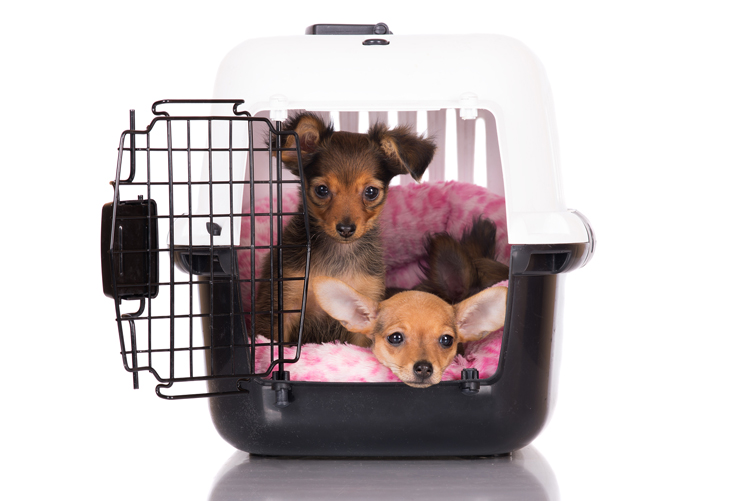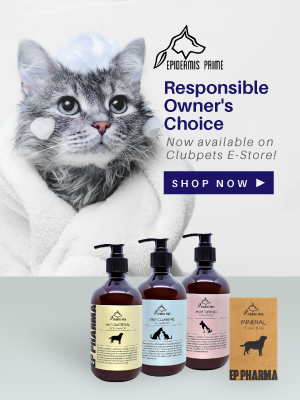Crate Training for Puppies

If you’ve noticed, dogs have a strong instinct to ‘den’ – meaning that they like to rest and sleep in small, confined spaces. A den provides the dog with a safe place to escape and lends a sense of security. A crate is also an invaluable tool for house-training. Puppies learn from their mothers that they shouldn’t soil their sleeping area.
As soon as they are able to, puppies will crawl away from where they sleep to a spot they designate as the toilet area, and eliminate there. A puppy cannot be expected to withstand more than four hours without using the toilet, and puppies used to soiling their beds are very hard to retrain.
As Easy as ABC
Crates are wonderful for keeping the puppy safe for short periods of time, especially when you have to leave it alone at home.
When introducing the puppy to a crate, it is important to make it a positive experience. Use treats to reinforce that the crate is a good place to be at. Some behaviourists and trainers suggest that you can try feeding it meals in the crate, leaving the door open. Meanwhile, place a small dish of water and a towel for bedding in the crate.
As the days progress, slowly move the bowls near the opening, then out of the crate, then farther and farther away from it. By tossing toys into the crate, you will also reinforce that the crate is a happy place to be. Crate association should start out a something pleasant rather than a scary and isolating place.
Use a special command when the puppy enters the crate, such as “go to bed” or “go sleep”, and always make this sound upbeat and lively. Once your puppy is entering the crate on its own, you can start closing the door. If you close the door when it’s happily eating away, it might not even notice at all.
If Puppy initially whines loudly or paws at the door, don’t make too much of a fuss. Say “no” or “quiet” in a firm tone and wait until it clams down before letting it out. If you relent and let it out when it whines, it will only reinforce this behaviour and cause crate training to fail.
The Perfect Crate
When shopping for a crate, always consider the size, the material it is made of, and the design.
1. A sturdy wire-frame dog crate is ideal as it is easy to clean, durable and offers good ventilation and visibility.
2. If you can find a dog crate that is foldable, it will be useful for travelling and homes with space constraints.
3. Choose a crate size big enough to accommodate your puppy when it becomes an adult, and which allows enough room for it to stand, sit and lie down without any restrictions. Since puppies grow very quickly, consider a design that can be sectioned off or expanded. If a crate has too much space, your puppy might consider it comfortable enough to actually find a toilet corner, which is exactly not what you want.
4. Do your research and scrutinise the design of the crate before buying it. When selecting a wire-frame crate, consider the size of the spaces between the wires. Be sure your puppy’s paws will not fall through the grids. Also, check for bad finishes and sharp edges. Check and make sure that the front door is not spring-loaded, as it could snap shut on a tail or a paw.
5. While plastic dog crates are easy to clean and are durable, they offer less in terms of ventilation as compared to a wire-frame crate. However, they are light and usually foldable, which make perfect travelling crates for cars.
Safe and Sound
Always remember to remove your puppy’s collar or any other accessories when it is in the crate. This will ensure that your furkid will not get snagged on the wire or on any protrusions in the crate, reducing the risk of injuries such as strangulation. As with other times, try using a break-away safety collar instead.
Never use the crate as a form of punishment or reprimand for your puppy. This simply causes the dog to fear and resent the crate. If correctly introduced to its crate, your puppy should be happy to go into its crate at any time. You may, however, use the crate as a brief time-out for your puppy as a way of discouraging nipping or excessive rowdiness.
The crate can be used to limit access to the house until the new puppy learns all the house rules – like what it can and can’t chew on, and where it can and can’t eliminate. Crate training takes some time and effort, but over time, you’ll notice that the puppy will find itself a quiet spot to retreat to.









